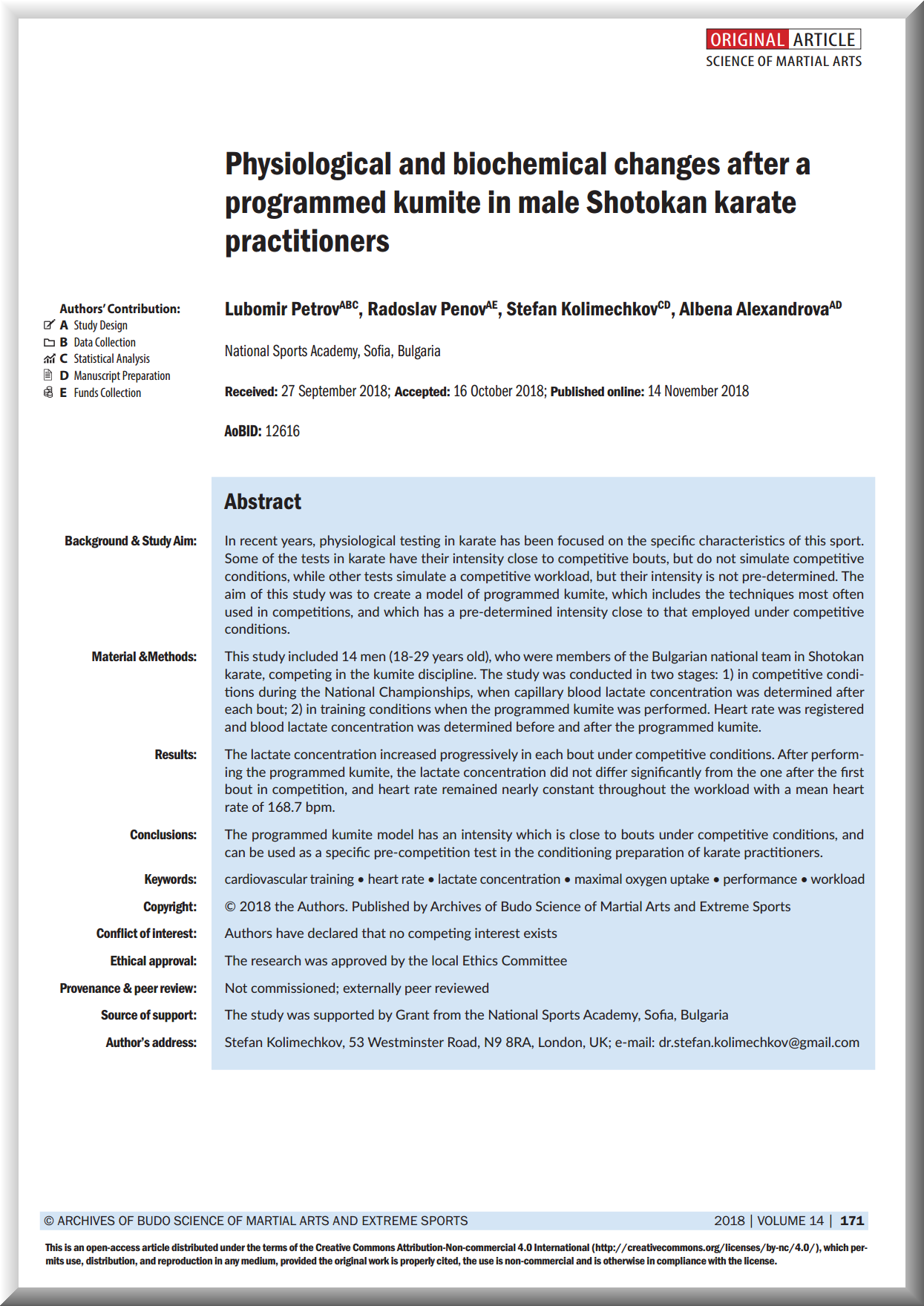Physiological and Biochemical Changes After a Programmed Kumite in Male Shotokan Karate Practitioners
Lubomir Petrov, Radoslav Penov, Stefan Kolimechkov, Albena Alexandrova
How to cite:
Petrov, L., Penov, R., Kolimechkov, S. & Alexandrova, A. (2018). Physiological and biochemical changes after a programmed kumite in male Shotokan karate practitioners. Archives of Budo Science of Martial Arts and Extreme Sports, 14, 171 - 178.

Archives of Budo Science of Martial Arts and Extreme Sports
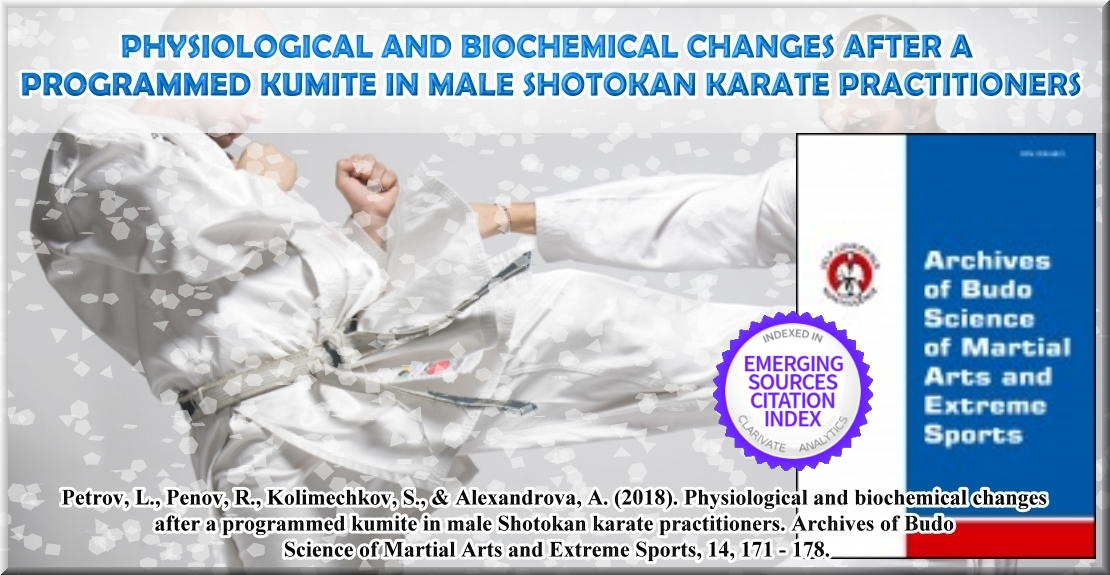
 Poland, Warsaw, Aleje Jerozolimskie 125/127 lok. 601B
Poland, Warsaw, Aleje Jerozolimskie 125/127 lok. 601B
e-mail: b.barczynski@archbudo.com | website: www.smaes.archbudo.com
ABOUT THE JOURNAL
The Archives of Budo Science of Martial Arts and Extreme Sports (SMAES) is an international peer reviewed journal publishing articles on various aspects of the sports sciences covering education and research in martial arts and combat sports, and related areas like biomechanics, kinesiology, medicine, psychology, sociology, technologies of sports equipment, research in training, selection, performance, survival, and other interdisciplinary perspectives. This journal is indexed in the international database Emerging Sources Citation Index (Web of Science).
ABOUT THIS ARTICLE
This study included 14 athletes from the Bulgarian national team in Shotokan karate. The article presents a newly created programmed kumite model, which is close to high intensity bouts in competitive conditions in Shotokan karate. This combination of techniques (programmed kumite model) can be used as a specific pre-competition test in the preparation of karate practitioners.
Physiological and Biochemical Changes After a Programmed Kumite in Male Shotokan Karate Practitioners
Published Journal Article
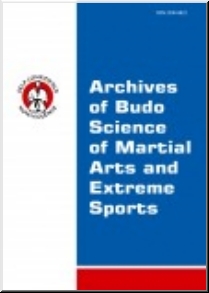
Archives of Budo Science of Martial Arts and Extreme Sports
Vol. 14, November 2018, pp. 175-187
PHYSIOLOGICAL AND BIOCHEMICAL CHANGES AFTER A PROGRAMMED KUMITE IN MALE SHOTOKAN KARATE PRACTITIONERS
Lubomir Petrov, Radoslav Penov, Stefan Kolimechkov, Albena Alexandrova
National Sports Academy, Sofia, Bulgaria
ABSTRACT
Background & Study Aim: In recent years, physiological testing in karate has been focused on the specific characteristics of this sport. Some of the tests in karate have their intensity close to competitive bouts, but do not simulate competitive conditions, while other tests simulate a competitive workload, but their intensity is not pre-determined. The aim of this study was to create a model of programmed kumite, which includes the techniques most often used in competitions, and which has a pre-determined intensity close to that employed under competitive conditions. Material & Methods: This study included 14 men (18-29 years old), who were members of the Bulgarian national team in Shotokan karate, competing in the kumite discipline. The study was conducted in two stages: 1) in competitive conditions during the National Championships, when capillary blood lactate concentration was determined after each bout; 2) in training conditions when the programmed kumite was performed. Heart rate was registered and blood lactate concentration was determined before and after the programmed kumite. Results: The lactate concentration increased progressively in each bout under competitive conditions. After performing the programmed kumite, the lactate concentration did not differ significantly from the one after the first bout in competition, and heart rate remained nearly constant throughout the workload with a mean heart rate of 168.7 bpm. Conclusions: The programmed kumite model has an intensity which is close to bouts under competitive conditions, and can be used as a specific pre-competition test in the conditioning preparation of karate practitioners.
Keywords: cardiovascular training, heart rate, lactate concentration, maximal oxygen uptake, performance, workload.
Glossary:
Kumite – is a semi-contact karate competitive concurrence, where two athletes perform various kicking, punching and blocking techniques towards each other with maximum control in order to gain points and win the match. Destruction is fictive.
Kata – prescribed patterns or sequences of techniques [17].
Performance – noun the level at which a player or athlete is carrying out their activity, either in relation to others or in relation to personal goals or standards [18].
Load – noun 1. a weight or mass which is supported 2. the force that a body part or structure is subjected to when it resists externally applied forces 3. the amount of something, usually weight, that a body part can deal with at one time [18].
Workload synonym of training load.
Training load – “A simple mathematical model of training load can be defined as the product of qualitative and quantitative factor. This reasoning may become unclear whenever the quantitative factor is called ‘workload volume’ or ‘training volume’ interchangeably with ‘volume of physical activity’. Various units have been adopted as measures i.e. the number of repetitions, kilometres, tons, kilocalories, etc. as well as various units of time (seconds, minutes, hours). As in the real world nothing happens beyond the time, the basic procedure of improvement of workload measurement should logically start with separation of the time factor from the set of phenomena so far classified together as ‘workload volume’. Due to the fact that the heart rate (HR) is commonly accepted as the universal measure of workload intensity, the product of effort duration and HR seems to be the general indicator of training load defined as the amount of workload.” [19].
Technique – noun a way of performing an action [18].
Cardio – noun same as cardiovascular training [18].
Cardiovascular training – noun exercise that raises the heart rate and increases circulation, strengthening the cardiovascular system and burning fat. Also called cardio [18].
Endurance – noun the ability or power to bear prolonged exertion, pain or hardship endurance athlete [18].
Endurance training – noun exercises designed to increase an athlete’s level of aerobic fitness [18].
INTRODUCTION
Karate is one of the most popular martial arts sports, being practised all around the world, and its most well-known styles are Shotokan, Shito-ryu, Goju-ryu, Wado-ryu, and Kyokushin. Karate includes two competitive disciplines: kumite and kata. Kumite athletes in Shotokan karate take part in ritualistic, non-contact fights in which the athletes demonstrate the potential force of their movements and execute them as in a real situation. This requires strict control of their movements, which have to be completed without inflicting harm on the opponent [1]. Competitions in the kumite discipline have a duration of two minutes for men [2]. The attack and defence in karate are short duration techniques, performed with maximum intensity and interrupted by short intervals that make the exercise comparable to an intermittent one [3].
The training process and testing of the karate practitioners have to be as similar as possible to the conditions in their competitions, in order for them to achieve high performance results. For this purpose, different specific tests, such as the KSAT test (Karate Specific Aerobic Test), have been created. The KSAT test was developed by Nunan [4] and is composed of sequential sets of straight punches and roundhouse kick combinations on a heavy punch bag. The set time for each movement is seven seconds, with progressively shortened resting times until exhaustion. Another similar test was introduced by Imamura et al. [5] in which the subjects perform 1,000 punches in 1,000 sec, followed by 1,000 kicks in 1,000 sec, with thirty minutes sitting rest between them. Although the intensity in these specific tests is pre-determined in order to correspond most closely with that experienced in the competitive environment, these tests do not fully replicate actual fights in competitions in the kumite discipline, neither in terms of their total duration, nor the rest periods.
Other authors follow the heart rate and lactate concentration of the karate practitioners in simulated kumite [6, 7]. During these tests, the workload is close to that in competitions, but the intensity does not correspond accordingly, which means that it is difficult to compare the results of different tests and different karate practitioners.
The aim of this study was to create a model of programmed kumite, which includes the techniques most often used in competitions, and which has a pre-determined intensity close to that employed under competitive conditions.
METHODS
Participants
This study included 14 male karate practitioners between the ages of 18 and 29 (mean age of 23.4 ±3.32 years) who competed in the kumite discipline. All of the participants were members of the Bulgarian national team in Shotokan karate, five of whom are gold medallists, one a silver medallist, and two bronze medallists at European Shotokan Karate Championships. Moreover, four of the participants are national gold medallists, and two are national silver medallists in Bulgarian Shotokan Karate Championships.
Ten of the fourteen karate practitioners, who were tested during the National Shotokan Karate Championships, took part in the second stage of this research.
The participants were informed about the purpose of this study, and signed informed consents were obtained, in accordance with the requirements of the Declaration of Helsinki for Human Research [8].
The anthropometric measurements and the maximal aerobic test were performed one week before the National Shotokan Karate Championships.
Design of the study
The study was conducted in two stages: 1) during the National Shotokan Karate Championships under the auspices of the Bulgarian Federation of Shotokan Karate, where the capillary blood lactate concentration of the karate practitioners was determined after their warm-up and after each bout, 2) during the pre-competition camp for the European Championships, at which location programmed kumite bouts (duration of 2 min.) were performed which were as close as possible in terms of their duration, intensity and series of techniques, to highly competitive bouts. The heart rate and physical activity of the karate practitioners were measured constantly during the programmed kumite, and the capillary blood lactate concentration was determined before and after the bouts.
Programmed kumite
1) A 30-second performance of the kizami-zuki technique (front snap punch); both partners perform a total of 10 strikes, each alternating during the sequence.
2) A 30-second performance of the kizami-zuki (jab punch) - gyaku-zuki (reverse punch) combination; both partners perform the combination consisting of 10 strikes in total, each alternating during the sequence.
3) A 30-second performance of the combination of kizami-zuki - gyaku-zuki - maswashi geri (roundhouse kick); both partners perform the combination comprised of 4 strikes in total, each alternating during the sequence.
4) A 30-second performance of the combination deai (counterattack: kizami-zuki and a counter strike with a gyaku-zuki); both partners perform the combination of 10 strikes in total, each alternating during the sequence.
Physical characteristics
Body weight (BW) with accuracy of 0.05 kg, percent body fat (%BF) and muscle mass percentage (%MM) were measured by using the Tanita Body Composition Monitor BC601. Body height (BH) was registered to the nearest 0.5 cm by using a stadiometer, and body mass index (BMI) was calculated as BW (kg) divided by BH (m) squared.
Maximal oxygen uptake (VO2max)
The maximal oxygen uptake (VO2max) was obtained by performing a maximal aerobic test using a cycle ergometer, according to the following protocol: the duration of each stage was 1 min 30 sec, the initial power was 60W, and the increase in each stage was 30W, until exhaustion. The analysis of exhaled gases (O2 and CO2) was performed in real time using a metabolic device, Jaeger-Pro, Germany. The capillary blood lactate concentration was determined in the 3rd, 6th and 9th minutes after the end of the aerobic test.
Lactate concentration (La)
Capillary blood was taken from the pendant of the athlete's ear, and the lactate concentration was determined using Lactate Pro 2 LT-1730, Arkray Global Business Inc., Japan.
Heart rate (HR)
Heart rate (HR) was registered using the Sigma pulse heart rate monitor, and recorded by the TEMEO telemetry system, produced by the Security Solutions Institute, Bulgaria [9] (Figure 1). The system also recorded the accelerations in three orthogonal axes (X, Y and Z) every 20 milliseconds using a built-in three-dimensional accelerometer. The data obtained were processed using the specialised software of the telemetry system.
The maximal heart rate (HRmax) of the karate practitioners was calculated according to the formula 208 bpm – 0.7 · age [10].
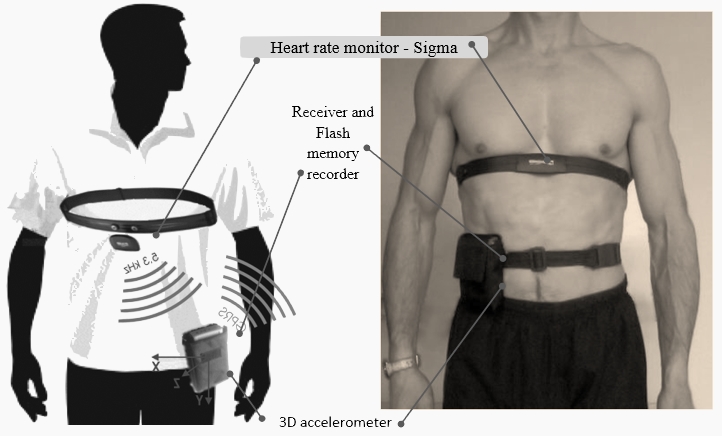
Figure 1: TEMEO telemetry system, produced by the Security Solutions Institute, Bulgaria.
Statistical analysis
The statistical analysis was performed using GraphPad 7.04 software. The values are presented as mean ±SD (standard deviation). The statistical significance of the differences in the mean values was checked using the One-Way ANOVA for repeated measures using the Tukey post hoc test (for the lactate concentration values after the National Championship bouts), and t-test for dependent samples (for the lactate concentration values after the programmed kumite).
RESULTS
The anthropometric data and the results from the maximal aerobic test of the male karate practitioners are presented in Table 1. The results showed that the height of the karate practitioners was between 177-187 cm, with only two lower values (165 and 170 cm). The BMI was within the norm, and only one athlete had BMI (26.3 kg/m2) above the normal weight cut-off of 25, but this is due to his great amount of muscle mass (MM% = 52.9%). All of the karate practitioners showed low values of %BF, two of whom had really low body fat (7.5% and 7.7%). The amount of muscle mass (%MM) was high in all of the participants (>47%).
The maximal heart rate (HRmax) of the karate practitioners, which was reached in their last stage of the maximal aerobic test, was close to the expected values (208 bpm – 0.7 · age).
The lactate concentration in the blood of all karate practitioners reached its maximum values in the 6th minute after the end of the maximal aerobic test, and only those values are presented in Table 1.
Table 1: Results of the anthropometric measurements and the maximal oxygen consumption test of the karate practitioners (n = 14).
Indicator |
Height |
Weight |
BMI |
BF % |
MM % |
Wmax/kg |
VO2max |
HRmax |
La 6' |
Mean |
178.3 |
72.2 |
22.8 |
10.4 |
50.1 |
3.5 |
51.7 |
187.1 |
12.3 |
SD |
7.54 |
4.69 |
2.07 |
1.89 |
1.92 |
0.49 |
3.68 |
4.49 |
1.37 |
Min |
165.0 |
68.0 |
20.1 |
7.5 |
47.9 |
2.6 |
48.0 |
180.0 |
10.3 |
Max |
187.5 |
81.5 |
26.3 |
12.5 |
52.9 |
4.3 |
58.2 |
193.0 |
14.5 |
Testing in competitive conditions
The individual values of the lactate concentration after the warm-up, and after the first, second, and third bouts from the National Shotokan Karate Championships in Bulgaria, are presented in Table 2. The lactate concentration increased significantly after the 1st bout (4.8 ±2.55 mmol/L, р<0.001), and after the 2nd bout (6.5 ±3.09 mmol/L, р<0.05). After the 3rd bout, the lactate concentration decreased, and it was similar to the one accumulated after the 1st bout. The mean lactate concentration after the 3rd bout was not significantly lower than the one after the 2nd bout. Only three karate practitioners reached the 3rd bout, and their La values were 3.7, 5.2 and 5.5 mmol/L, which is close to the anaerobic threshold (4.0 mmol/L). Athletes Code6, -8 and -10 showed higher individual values than those of the other practitioners in the group (these values are shown in bold in Table 2).
Table 2: Individual and mean values of the lactate concentration (La) after the warm-up, first, second, and third bouts during the National Shotokan Karate Championships (n = 14).
Code karate athletes |
La concentration after: |
|||
warm-up |
1st bout |
2nd bout |
3rd bout |
|
1 |
0.9 |
2.9 |
7.0 |
|
2 |
1.4 |
4.1 |
||
3 |
1.1 |
5.2 |
||
4 |
1.2 |
2.9 |
||
5 |
1.7 |
3.4 |
4.3 |
5.2 |
6 |
1.6 |
11.5 |
||
7 |
1.6 |
5.2 |
||
8 |
1.1 |
4.5 |
9.8 |
5.5 |
9 |
1.1 |
4.1 |
4.4 |
3.7 |
10 |
1.7 |
7.6 |
11.7 |
|
11 |
1.3 |
2.9 |
4.5 |
|
12 |
1.1 |
7.7 |
||
13 |
1.0 |
3.2 |
||
14 |
1.4 |
2.2 |
4.1 |
|
Descriptive statistics |
||||
mean |
1.3 |
4.8*** |
6.5 ∆ |
4.8 |
SD |
0.27 |
2.55 |
3.09 |
0.96 |
min |
0.9 |
2.2 |
4.1 |
3.7 |
max |
1.7 |
11.5 |
11.7 |
5.5 |
***p<0.001 vs the initial La after the warm-up;
∆ p<0.05 vs the La after the 1st bout.
Testing in training conditions
Ten of the fourteen karate practitioners, who were tested during the National Shotokan Karate Championships, took part in the second stage of this research. The programmed kumite bouts (2 minutes, 100% effective time) in training conditions were performed in this second research stage, which was at the pre-competition camp for the European Championships. Heart rate was monitored throughout the programmed kumite, and reached a mean value of 168.7 ±5.43 bpm. The data from one of the tested karate practitioners is presented in Figure 2.
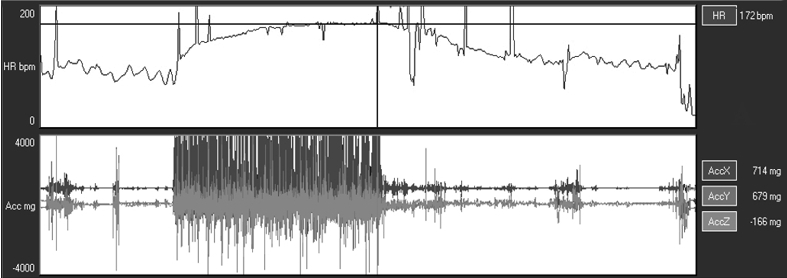
Figure 2: Records from the heart rate with few artefacts (top) and the physical activity data measured by the three-dimensional accelerometer (bottom) during the programmed kumite in one of the athletes.
The lactate concentration increased in all ten karate practitioners after the programmed kumite, and the highest registered values were 4.7 mmol/L and 4.4 mmol/L (athletes Code1 and Code8, respectively). The individual values of the lactate concentration before the start of the programmed kumite (after the warm-up), and after the completion of the programmed kumite, are presented in Figure 3. The mean values of the lactate concentration in the blood of the athletes increased significantly after performing the programmed kumite (3.5 ±0.74 mmol/L vs 1.3 ±0.25 mmol/L, р<0.05). The lactate concentration obtained after the programmed kumite does not differ from the one registered after the first bout under competitive conditions (3.5 ±0.74 mmol/L vs 4.8 ± 2.55 mmol/L, p>0.05).
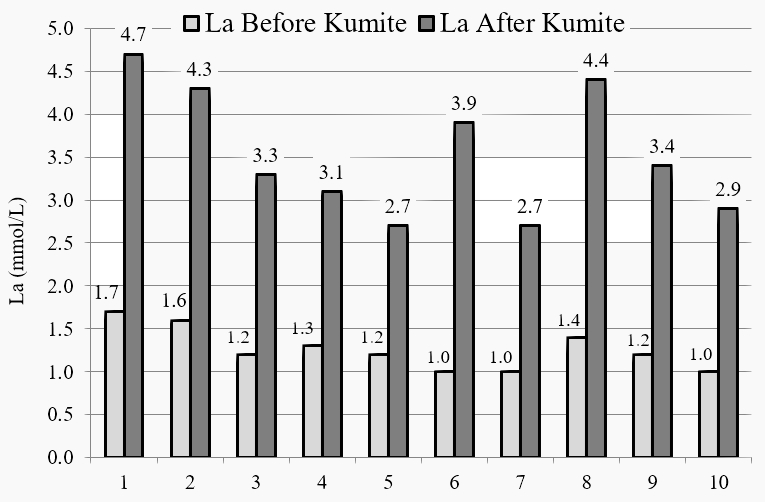
Figure 3: Individual values of the lactate concentration in the karate practitioners before and after the programmed kumite (n = 10) – second research stage (code from 1 to 10 as in Table 2).
DISCUSSION
The anthropometric data showed that the karate practitioners in our study had their BMI (22.8 ±2.07 kg/m2) within the norm, and this is close to other published data for athletes in this sport: BMI 23.3 kg/m2 [1], and BMI 22.4 kg/m2 in karate practitioners at international level, and BMI = 22.56 kg/m2 at national level [11]. The Bulgarian karate practitioners from our study had slightly higher mean values of VO2max (50.04 ±6.04 mL/kg/min) in comparison with those reported by Doria et al. [1] (48.5 ±6.0 mL/kg/min), but lower values than those registered by Tabben et al. [11] (57.2 ± 3.7 mL/kg/min for international level karate practitioners and 56.0 ± 1.6 mL/kg/min for national level practitioners). One of the athletes in our study (Code8) reached VO2max/kg 58.16 mL/kg/min, which is a very good result and is comparable to practitioners at international level. The karate practitioners in our study showed a slightly higher percentage of body fat (10.4 ±1.89%) in comparison with the karate competitors at international (7.2 ±0.7%) and those at national level (9.2 ±2.8%) [11], with two of the athletes tested in our study showing similar low values of body fat (7.5% and 7.7%).
According to Beneke et al. [12], the main energy supply in kumite discipline comes from the aerobic system, with a contribution of 77.8 ±5.8%. However, during interactions, the main energy comes from the anaerobic alactic system (ATP-CP), with a contribution of 16 ±.6%, and only 6.2 ±2.4% is contributed by the anaerobic lactic system [12]. The predominant aerobic energy supply explains the slightly higher than the anaerobic threshold of 4.0 mmol/L (Table 2) lactate in the blood of the karate practitioners from our study, registered after the first bout in the National Shotokan Karate Championships in Bulgaria. To the best of our knowledge, there is limited data in the scientific literature on the dynamics of lactate concentration in the blood of karate practitioners in real competitive conditions. For instance, Zaborski B. et al. [14] showed only in graphs the lactate values in competitive kumite, which were around 8.0 mmol/L. Our study demonstrated such an increase of lactate concentration after the second bout in three of the karate practitioners (Code1, -8, -10). This increase is probably due to the greater difficulty of the fights, as well as incomplete recovery between the individual bouts. The insignificant decrease of the mean lactate concentration which followed after the third bout (4.8 ±0.96 mmol/L) was probably due to the fact that only the athletes who were more skilful, and who possessed a better aerobic work capacity, reached the third bout. Those same athletes also showed the highest values of maximum oxygen uptake (51.03 mL/kg/min, 58.16 mL/kg/min and 56.44 mL/kg/min). It is also important to note the more static nature of the final bouts, which usually involve karate practitioners with great sports experience.
Lactate concentration levels in the blood of karate practitioners, as well as heart rate, are very often used in different types of karate training as an indicator of their current physiological level [11, 13]. According to some authors, the physiological workload imposed on the body, assessed by the changes in lactate concentration [13, 15], as well as the changes in the heart rate curve [15, 16], revealed the level of La concentration to be lower in training, in comparison with that obtained under competitive conditions. In our study, we registered all these parameters in training conditions, while we created a programmed model which was as close as possible to the intensity and the techniques mostly used in competitive conditions. The lactate concentration (La) obtained after the programmed kumite showed similar values to those measured after the bouts in the National Championships. The mean La values were 3.5 ±0.74 mmol/L after the programmed kumite, and 4.8 ±2.55 mmol/L after competition. Those results confirm the data in the scientific literature showing lower La values in training conditions vs competitive ones [13, 14].
The mean heart rate after the programmed kumite was 168.7 ±5.43 bpm (90% of the HRmax during the maximal aerobic test), and remained almost constant during the workload (Figure 2). Such a heart rate is expected during aerobic physical activity, with around 70-75% of VO2max, and this is within the range of the recommended training heart rate zone which is required in order to develop endurance (cardio training). For example, during seven consecutive kumite bouts, with two minutes’ passive recovery in between, Tabben et al. [11] registered heart rate values of 73.4 ±2.6% from the HRmax in French international level karate practitioners. In our opinion, performing such programmed kumite several times consecutively, with breaks of 2 min, would provide sufficient cardio training.
CONCLUSIONS
The newly created programmed kumite model is close to high intensity bouts in competitive conditions, and can be used as a specific pre-competition test in the preparation of karate practitioners. The results showed that the lactate concentration in the blood of the athletes while performing the programmed kumite reached similar values to those in competitions. Moreover, lactate concentration varies over a wider range of values, and it constitutes a more accurate indicator than heart rate when testing physical workload. It can be assumed that after the programmed kumite, karate practitioners with lactate concentration lower than the average (3.5 mmol/L) demonstrate better functional preparation for upcoming competitions.
REFERENCES
1. Doria C, Veicsteinas A, Limonta E et al. Energetics of karate (kata and kumite techniques) in top-level athletes. Eur J Appl Physiol 2009; 107(5): 603-610
2. World Shotokan Federation. WSF Competition Rules [Internet]. Basel: World Shotokan Federation; [cited 2018 Nov 03]. Available from: https://worldshotokan.org/
3. Milanez VF, Dantas JL, Christofaro DGD et al. Heart rate response during a karate training session. Rev Bras Med Esporte 2012; 18(1): 42-45
4. Nunan D. Development of a sports specific aerobic capacity test for karate - a pilot study. J Sports Sci Med 2006; 5(CSSI): 47-53 5.
5. Imamura H, Yoshimura Y, Nishimura S et al. Oxygen uptake, heart rate, and blood lactate responses during 1,000 punches and 1,000 kicks in female collegiate karate practitioners. J Physiol Anthropol Appl Human Sci 2003; 22(2): 111-114
6. Chaabène H, Mkaouer B, Franchini E et al. Physiological Responses and Performance Analysis Difference between Official and Simulated Karate Combat Conditions. Asian J Sports Med 2014; 5(1): 21-29
7. Loturco I, Nakamura1 FY, Lopes-Silva JP et al. Physical and physiological traits of a double world karate champion and responses to a simulated kumite bout: A case study. Int J Sports Sci Coach 2017; 12(1): 138-147
8. World Medical Association. Declaration of Helsinki - Ethical Principles for Medical Research Involving Human Subjects. Ferney-Voltaire: World Medical Association; 2013 [ited 2018 Nov 03]. Available from: https://www.wma.net/policies-post/wma-declaration-of-helsinki-ethical-principles-for-medical-research-involving-human-subjects/
9. Mateev H, Simova I, Katova T et al. Clinical evaluation of a mobile heart rhythm telemonitoring system. ISRN Cardiol 2012; 2012: 192670
10. Tanaka H, Monahan KD, Seals DR. Age-predicted maximal heart rate revisited. J Am Coll Cardiol 2001; 37(1): 153-156
11. Tabben M, Chaabène H, Franchini E et al. The influence of karate practice level and sex on physiological and perceptual responses in three modern karate training modalities. Biol Sport 2014; 31(3): 201-207
12. Beneke R, Beyer T, Jachner C et al. Energetics of karate kumite. Eur J Appl Physiol 2004; 92(4-5): 518-523
13. Imamura H, Yoshimura Y, Nishimura S et al. Physiological responses during and following karate training in women. J Sports Med Phys Fitness 2002; 42(4): 431-437
14. Zaborski B, Šakiri K, Dukanović N et al. Changes in The Physiological Processes During Training and Official Competitions in Young Karate Athletes. Sportske Nauke Zdravlje 2015; 5(2): 105-110
15. Markovic G, Vucetic V. Heart rate and lactate responses to Taekwondo fight in elite women performers. Biol Sport 2008; 25(2): 135-146
16. Shaw DK, Deutsch DT. Heart rate and oxygen uptake response to performance of karate kata. J Sports Med Phys Fitness 1982; 22(4): 461-468
17. Budō: The Martial Ways of Japan. Tokyo: Nippon Budokan Foundation; 2009
18. Dictionary of Sport and Exercise Science. Over 5,000 Terms Clearly Defined. London: A & B Black; 2006
19. Kalina RM. Methodology of measurement, documentation and programming optimal workload continuous with variable intensity – applications in sports medicine, physiotherapy, geriatrics, health-related training, sport for all. Arch Budo 2012; 8(4): 235-249
Full Text: Physiological and Biochemical Changes After a Programmed Kumite in Male Shotokan Karate Practitioners. Archives of Budo Science of Martial Arts and Extreme Sports
Available on the official website of the Journal
This article is also available on ResearchGate
Authors
Associate Professor Dr Lubomir Petrov PhD
Department of Physiology and Biochemistry, National Sports Academy, Sofia, Bulgaria
Academia.edu | ORCID | Research Gate | Google Scholar
Assistant Professor Radoslav Penov PhD
Department of Wrestling and Judo, National Sports Academy, Sofia, Bulgaria
The Founder and President of Karate Fighters Club – NSA
e-mail: fighters.nsa@abv.bg
Stefan Kolimechkov PhD
Department of Physiology and Biochemistry, National Sports Academy, Sofia, Bulgaria
Academia.edu | ORCID | Research Gate | Google Scholar
Associate Professor Albena Alexandrova PhD
Department of Physiology and Biochemistry, National Sports Academy, Sofia, Bulgaria
Academia.edu | ORCID | Research Gate | Google Scholar
Corresponding author: e-mail: dr.stefan.kolimechkov@gmail.com
ISSN: 2300-8822
E-ISSN: 2300-8822
How to cite this article:
Petrov, L., Penov, R., Kolimechkov, S. & Alexandrova, A. (2018). Physiological and biochemical changes after a programmed kumite in male Shotokan karate practitioners. Archives of Budo Science of Martial Arts and Extreme Sports, 14, 171 - 178.
